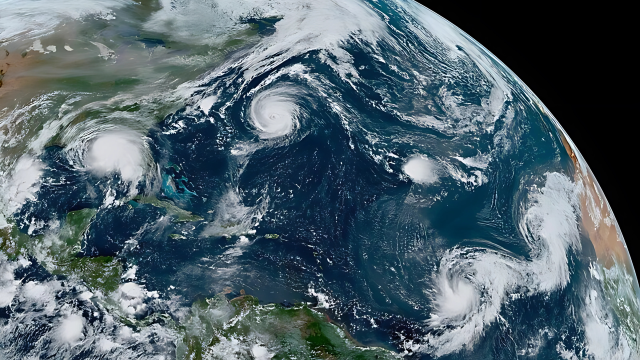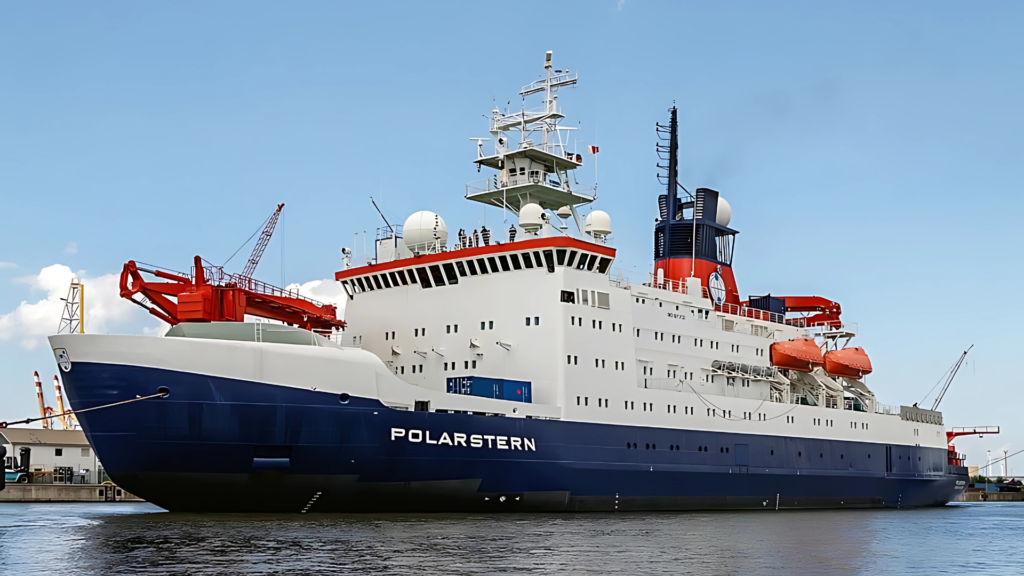16
Apr
Pesticides Found in Marine Atmosphere Over Deep Atlantic Ocean, Documented for the First Time

(Beyond Pesticides, April 16, 2025) Documented for the first time, 15 currently used pesticides (CUPs) and four metabolites (breakdown or transformation products—TP) were found in the marine atmosphere over the Atlantic Ocean. Three legacy (banned) pesticides were also discovered. According to a recent study published in Environmental Pollution, researchers found empirical evidence for pesticide drift over remarkably long distances to remote environments.
The findings of this study build on existing research that pollution knows no borders or boundaries, emphasizing Beyond Pesticides’ mission to advocate for the value of the precautionary principle through the elimination of synthetic chemicals and replacement with organic systems that address the root causes of pest pressures–including systemic failure to feed soil microbial life. Â
Background and Methodology
“In this study, 329 pesticides, including 282 CUPs and 36 transformation products, were [sampled for] in the atmosphere across a south-north transect on the Atlantic Ocean,” said the authors. They unpack the three main objectives to address the focus and major objectives of their research:
- “[T]he determination of pesticide concentrations in the atmosphere of the Atlantic Ocean,
- The investigation of the spatial distribution of pesticides across the Atlantic Ocean, and
- The elucidation of potential sources and factors influencing pesticide transport in the investigated area.”
The study authors are based at various universities and research institutes in Germany, including the Centre for Materials and Coastal Research, Rostock University, and Hamburg University.
In order to achieve these objectives, researchers collected air samples using glass-fiber filters and collected gaseous samples using slices of polyurethane foam and 55 grams of Amberlite XAD-2 resin housed in a glass column (PUF/XAD-2 column). To engage in this broad-spectrum analysis, researchers applied both gas chromatography and liquid chromatography coupled to mass spectrometry. Twelve air samples were gathered between two and five days, “depending on the distance to land and movement of air masses [in order to] ensure… detectable pesticide concentrations in each sample.” Samples were collected on a research vessel on a pathway from Punta Arenas, Chile, to Bremerhaven, Germany.

Figure 1: The study authors gathered air samples for this study on the research vessel and Icebreaker “Polarstern.” Image credit: Llez from Own Work, CC BY-SA 3.0, via Wikimedia Commons.
Findings
“In total, twenty-two pesticides were found in the air above the Atlantic Ocean, including fifteen CUPs, four transformation products, and three legacy pesticides,” the authors report in the results and discussion section of this report. “All main pesticide groups were present and equally represented, namely six insecticides, five herbicides, seven fungicides, and four transformation products. Seventeen pesticides were present in the gaseous phase only, two pesticides were found in the particulate phase only, and three pesticides were found in both phases.”
The CUPs include the insecticides bifenthrin, carbofuran, flonicamid, and flupyradifurone; the fungicides cyflufenamid, dicloran, dimethomorph, fenpropidin, fluopyram, and tebuconazole; the herbicides clopyralid, fenuron, flumioxazin, isoxaflutole, and metamitron; the transformation products metalaxyl metabolite CGA 62826, metolachlor ethane sulfonic acid, metolachlor oxanilic acid, and prothioconazole desthio; and the legacy pesticides 2,4’-DDE, 4,4’-DDD, and hexachloro-benzene.
Pesticide concentrations are generally higher in the northern hemisphere, with the European coastline having the highest concentrations found for this study. Of particular note is that this study is the first to provide empirical evidence for the potential for long-range transport (LRT) of twelve additional CUPs and four TPs in the marine atmosphere across the Atlantic Ocean after previous research in recent years found initial evidence for the other three (fenpropidin, S-metolachlor, and tebuconazole) in 2024. (See the previous paragraph for the list of pesticides.) Understanding the potential for long-range atmospheric transportation of pesticides is crucial not only for national regulators hoping to address chemical pollution within the boundaries of their countries but also for governments’ compliance with the international Stockholm Convention on Persistent Organic Pollutants, which is a treating that signed by 152 countries worldwide that bans persistent organic (meaning containing carbon) pollutants. The United States has not joined over 150 countries in ratifying a 2001 United Nations treaty known as the Stockholm Convention on Persistent Organic Pollutants, which requires the elimination of persistent organic pollutants’ (POPs) production, use, and/or release. (See here and here for Beyond Pesticides coverage).
The researchers highlight how their empirical evidence opens the door for these new pesticide products to be considered as compounds that undergo LRT potential as defined in the Convention: The Stockholm Convention defines relevant compounds to have “measured levels in locations distant from source regions that are of potential concern.”
![Image credit: ©[blurAZ from Getty Images] via Canva.com](https://beyondpesticides.org/dailynewsblog/wp-content/uploads/2025/04/DN-4.16.25_body-Image_2-1024x576.png)
Figure 2: The United Nations Headquarters in New York, USA. Image credit: ©[blurAZ from Getty Images] via Canva.com
Previous Coverage
There has been mounting scientific evidence of pesticide drift into the seemingly most out-of-reach and perplexing of locations, as previously covered in the Daily News. In 2024, a team of researchers from San Diego State University and the University of California, San Diego, published a study in Environmental Science & Technology Letters on the impact of legacy pesticides on the long-term ecosystem health of the Superfund-designated Southern California Bight zone, an area known for its historic and tragic dumping of DDT waste. This study, funded by the National Oceanic and Atmospheric Administration (NOAA), was the first to find halogenated organic compounds (HOCs) in deep ocean sediment and biota, identifying 49 compounds, many of which were DDT-related and not previously screened.
The adverse health impacts of persistent organic pollutants (POPs), including banned legacy pesticides such as DDT and their metabolites, have also been found in the blubber of infant and younger humpback whales, based on published research by NOAA and the Center for Coastal Studies in Massachusetts. (See Daily News here.)
Additional studies have unpacked the bioaccumulative and adverse health effects of pesticides in salt and freshwater ecosystems alike, including coral reefs. A 2024 study published in Marine Pollution Bulletin found that large benthic foraminifera (LBF)—single-celled organisms found on reefs that researchers utilize as a “canary in the coal mine” for coral reef health—face adverse metabolic impacts after exposure to the weed killer glyphosate and insecticide imidacloprid. The study found that “even the lowest doses of the fungicide and herbicide caused irreparable damage to the foraminifera and their symbionts.” (See Daily News here.)
There are numerous peer-reviewed studies in the scientific literature that underscore the connection between synthetic pesticide use, exposure, and drift to deleterious effects on ecosystem health, including marine ecosystems and aquatic life. See the dedicated Daily News sections on aquatic organisms, biodiversity, oceans, water, and wildlife/endangered species for further information and insights.
Call to Action
Communities around the country continue to look for opportunities to support biodiversity conservation, public health, and climate resilience. Please consider subscribing to the Action of the Week and Weekly News Update to engage with decision-makers on pivotal issues and receive pertinent policy and science updates from the Beyond Pesticides team, respectively.
You can prevent pesticide air volatilization and drift into waterways and soil by asking your mayor to adopt organic land management policy and programs for your community’s parks and public spaces. (See Action of the Week here.)
Featured Image credit: https://www.star.nesdis.noaa.gov/GOES/index.php from NOAA, Public Domain, via Wikimedia Commons.
Figure 1 credit: Llez from Own Work, CC BY-SA 3.0, via Wikimedia Commons.
Figure 2 credit: ©[blurAZ from Getty Images] via Canva.com
All unattributed positions and opinions in this piece are those of Beyond Pesticides.
Source: Environmental Pollution










